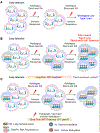An ordeal that does not heal: understanding barriers to a cure for HIV-1 infection
- PMID: 35905706
- PMCID: PMC9346997
- DOI: 10.1016/j.it.2022.06.002
An ordeal that does not heal: understanding barriers to a cure for HIV-1 infection
Abstract
With more than 38 million people living with HIV-1 (PLWH) worldwide, developing a cure for HIV-1 remains a major global health priority. Lifelong persistence of HIV-1 is frequently attributed to a pool of stable, transcriptionally silent HIV-1 proviruses, which are unaffected by currently available antiretroviral therapy (ART) or host immune activity. In this opinion article, we propose a more dynamic interpretation of HIV-1 reservoir cell biology and argue that HIV-1 proviruses frequently display residual viral transcriptional activity, making them vulnerable to longitudinal immune-mediated selection processes. Such mechanisms may, over extended periods of ART, induce an attenuated viral reservoir profile characterized by intact proviruses preferentially integrated into heterochromatin locations. We suggest that intensifying and accelerating naturally occurring selection mechanisms might represent a promising strategy for finding a potential cure for HIV-1 infection.
Keywords: HIV; cure; eradication; immune selection; latency; reservoirs.
Copyright © 2022 Elsevier Ltd. All rights reserved.
Conflict of interest statement
Declaration of interests The authors have no interests to declare.
Figures

References
Publication types
MeSH terms
Grants and funding
- R01 AI078799/AI/NIAID NIH HHS/United States
- K24 AI155233/AI/NIAID NIH HHS/United States
- R01 HL134539/HL/NHLBI NIH HHS/United States
- R61 DA047034/DA/NIDA NIH HHS/United States
- R01 AI130005/AI/NIAID NIH HHS/United States
- R01 AI150396/AI/NIAID NIH HHS/United States
- R01 AI120008/AI/NIAID NIH HHS/United States
- UM1 AI164562/AI/NIAID NIH HHS/United States
- U01 AI135940/AI/NIAID NIH HHS/United States
- R37 AI155171/AI/NIAID NIH HHS/United States
- UM1 AI164570/AI/NIAID NIH HHS/United States
- U01 AI114235/AI/NIAID NIH HHS/United States
- R33 DA047034/DA/NIDA NIH HHS/United States
- R01 AI152979/AI/NIAID NIH HHS/United States
- U01 AI117841/AI/NIAID NIH HHS/United States
- R01 DK120387/DK/NIDDK NIH HHS/United States
- UM1 AI164560/AI/NIAID NIH HHS/United States
- R33 AI116228/AI/NIAID NIH HHS/United States
- R21 AI116228/AI/NIAID NIH HHS/United States
- UM1 AI164566/AI/NIAID NIH HHS/United States
LinkOut - more resources
Full Text Sources
Other Literature Sources
Medical

